Thiazide Diuretics: Pharmacology Made Easy & Clinical Relevant
Thiazide diuretics are a cornerstone of hypertension care. Understand how their mechanisms lower BP, anticipate side effects, and know what to monitor - so you can apply them confidently in everyday practice. Don’t just memorize; master the pharmacology.

This episode of This Is Why with Dr. Busti dives deep into thiazide and thiazide-like diuretics, one of the most impactful and enduring drug classes in cardiovascular medicine. Dr. Busti unpacks the mechanism of action, pharmacokinetics, clinical uses, and side effects of agents like hydrochlorothiazide, chlorthalidone, indapamide, and metolazone—connecting each concept to the “why” behind their clinical application. Listeners will gain clarity on how these drugs fit into hypertension management, how renal physiology drives their effects, and what to monitor for safe, effective patient care.
Access bonus materials and downloads at https://thisiswhy.health
Disclaimer: This content is for educational purposes only and is not intended to provide medical advice, diagnosis, or treatment. Always seek the advice of your physician or other qualified health provider with any questions you may have regarding a medical condition. Never disregard professional medical advice or delay in seeking it because of something you have heard in this content.
Chapter Table of Contents
00:00 – Introduction: Why Thiazides Still Matter
03:00 – Key Drugs in the Thiazide Class
07:00 – Clinical Uses and Indications
12:00 – Mechanism of Action Explained
20:00 – How Thiazides Work in the Nephron
28:00 – Pharmacokinetics and Dosing Insights
36:00 – Common Side Effects and Risks
45:00 – Major Drug Interactions
52:00 – Monitoring and Patient Counseling
59:00 – Key Takeaways and Closing Thoughts
More than just access—it’s where understanding deepens.
Create a free account or log in to gain access to this content!

Dive Deeper
Bonus Video (ad free)
Downloads
Thiazide Diuretics Tables
Dive Deeper
Bonus Video
Downloads
Thiazide Diuretics Tables

























